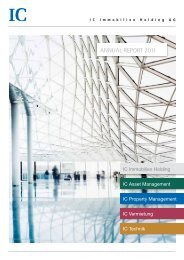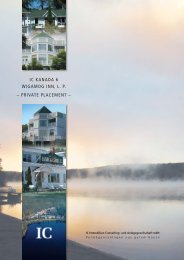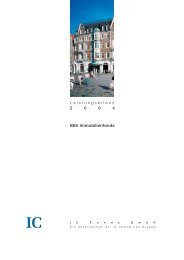Utilization of Tunnels as Sources of Ground Heat - iC group of ...
Utilization of Tunnels as Sources of Ground Heat - iC group of ...
Utilization of Tunnels as Sources of Ground Heat - iC group of ...
Create successful ePaper yourself
Turn your PDF publications into a flip-book with our unique Google optimized e-Paper software.
shafts and also parts <strong>of</strong> the enclosing bored pile<br />
walls are used.<br />
• U2/2 – Taborstraße<br />
The station Taborstraße is built diagonally under a<br />
traffic crossing. The Taborstraße access shaft is primarily<br />
used <strong>as</strong> absorber building. The diaphragm<br />
walls, bored piles and the b<strong>as</strong>e plate are equipped<br />
with absorbers. Parts <strong>of</strong> the station tunnels are used,<br />
too - the invert <strong>as</strong> well <strong>as</strong> individual inner lining<br />
blocks.<br />
Figure 4: Cross section <strong>of</strong> typical U2 metro station equipped<br />
for geothermal energy use.<br />
• U2/3 – Praterstern<br />
The station is situated underground e<strong>as</strong>t <strong>of</strong> the Austrian<br />
Railways station. In the course <strong>of</strong> the construction<br />
works the existing U1 station Praterstern must<br />
be rearranged. The geothermal energy is extracted<br />
via the diaphragm walls <strong>of</strong> the station <strong>as</strong> well <strong>as</strong> the<br />
total b<strong>as</strong>e slab.<br />
• U2/4 – Messe<br />
The station Messe is on the side <strong>of</strong> the Prater exhibition<br />
center under a main road. Since the power demand<br />
<strong>of</strong> this station is comparatively low, only a<br />
part <strong>of</strong> the b<strong>as</strong>e slab is equipped with absorbers.<br />
4 PROJECT DEVELOPMENT<br />
4.1 Fe<strong>as</strong>ibility study<br />
In spring <strong>of</strong> 2001, the Vienna Metro Authority<br />
“Wiener Linien” requested a study on the fe<strong>as</strong>ibility<br />
<strong>of</strong> geothermal utilization at the metro lot U2/2 Taborstraße.<br />
Since the results were encouraging, further<br />
detailed studies were performed for lots U2/1,<br />
U2/3 and U2/4.<br />
These intensified fe<strong>as</strong>ibility studies covered a<br />
comparison <strong>of</strong> the attainable energy with the required<br />
power amount, the general absorber layout <strong>of</strong><br />
the four metro station buildings and an extensive<br />
calculation <strong>of</strong> economic efficiency, which resulted in<br />
comparatively low operating costs particularly due<br />
to the large cooling demand <strong>of</strong> the stations and <strong>as</strong>sociated<br />
short amortization periods.<br />
heating/cooling [kWh/month]<br />
20000<br />
15000<br />
10000<br />
5000<br />
0<br />
-5000<br />
-10000<br />
heating/cooling demand<br />
heating/cooling output<br />
6,7<br />
7,1<br />
12,7<br />
15,3<br />
17,8<br />
22,9<br />
23,1<br />
24<br />
brine temperature (return<br />
flow)<br />
HEATING<br />
24,6<br />
20,7<br />
18,6<br />
Jan.<br />
Feb.<br />
March<br />
April<br />
May<br />
June<br />
Juli<br />
August<br />
Sept.<br />
Okt.<br />
Nov.<br />
Dez.<br />
COOLING<br />
Figure 5: <strong>Heat</strong>ing and cooling requirements, annual distribution.<br />
A substantial component <strong>of</strong> the fe<strong>as</strong>ibility study<br />
w<strong>as</strong> a risk analysis <strong>of</strong> geothermal facility units and<br />
the treatment <strong>of</strong> environmentally relevant <strong>as</strong>pects. It<br />
w<strong>as</strong> demonstrated, that the temperature variations<br />
have a negligible effect on the load-bearing capacity<br />
<strong>of</strong> the soil and the building components. Effects <strong>of</strong><br />
earthquakes could be excluded <strong>as</strong> a design criterion.<br />
Also, in c<strong>as</strong>e <strong>of</strong> damages to individual absorber<br />
loops the capability <strong>of</strong> the total system is guaranteed,<br />
since those circuits can be disconnected without<br />
problems.<br />
The results <strong>of</strong> the fe<strong>as</strong>ibility studies led finally to<br />
the implementation <strong>of</strong> geothermal facilities in all<br />
four metro station buildings. The design <strong>of</strong> the individual<br />
units w<strong>as</strong> performed by <strong>iC</strong> consulenten, the<br />
scientific support w<strong>as</strong> provided by the Department<br />
<strong>of</strong> Civil Engineering, Vienna University <strong>of</strong> Technology,<br />
Austria.<br />
4.2 Statutory procedures<br />
Since the power supply <strong>of</strong> a building is part <strong>of</strong> the<br />
Environmental Impact Statement (EIS), a potential<br />
geothermal utilization must be considered already in<br />
this project ph<strong>as</strong>e. Within the scope <strong>of</strong> the integrated<br />
approach <strong>of</strong> an EIA this is a benefit for the project<br />
developers, since the impact <strong>of</strong> a geothermal facility<br />
on the environment is more or less always positive.<br />
So these <strong>as</strong>pects can be counterbalanced against<br />
other disadvantageous effects <strong>of</strong> the project.<br />
The legal permits for the geothermal facilities<br />
could be attained without large difficulties, since extensive<br />
experiences from the application at high-rise<br />
projects and a previous test plant were available.<br />
Regarding the influence <strong>of</strong> the geothermal plants on<br />
the groundwater, detailed numerical calculations<br />
showed that a me<strong>as</strong>urable influence on groundwater<br />
temperatures can only be discerned at a distance <strong>of</strong><br />
less than five meters from the diaphragm walls.<br />
<strong>Ground</strong>water flow further reduces this effect.<br />
4.3 Tender design<br />
The tender <strong>of</strong> geothermal facilities is characterized<br />
very strongly by the fact that there are only few<br />
competent bidders for construction works in this<br />
market segment. The preferential form <strong>of</strong> the tender<br />
8<br />
35<br />
30<br />
25<br />
20<br />
15<br />
10<br />
5<br />
0<br />
-5<br />
brine temperatur [°C]
















